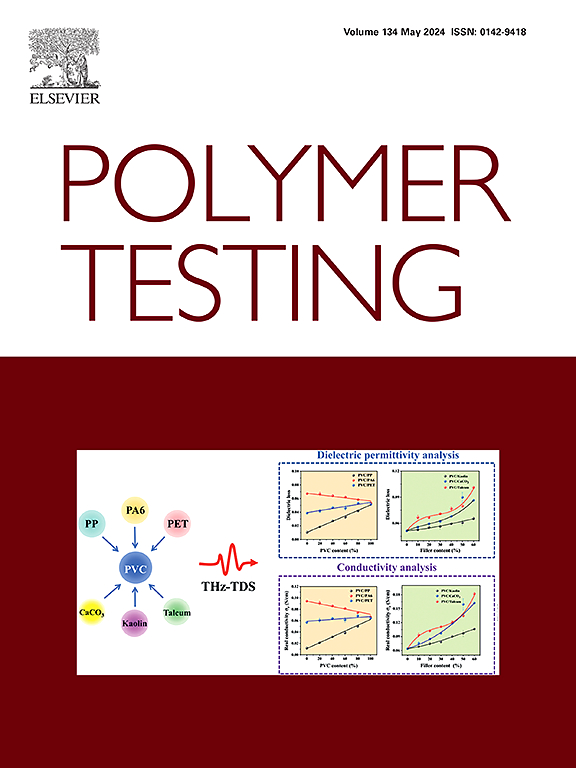Mesoscopic analysis and prediction of in-situ effect in FFF 3D printing CFRP/GFRP
IF 5
2区 材料科学
Q1 MATERIALS SCIENCE, CHARACTERIZATION & TESTING
引用次数: 0
Abstract
The inadequate computational methodologies for fused filament fabrication (FFF) 3D printing components, particularly in addressing interlayer characteristics, have hindered their widespread engineering applications. This paper presents a novel computational framework for in-situ effect determination, which identifies transverse tensile strength and shear strength (Y, S) through exhaustive search matching experimental ultimate tensile strength data, with the converged solutions being determined as authentic in-situ effect values (Yis, Sis). Based on this method, the in-situ effect distribution patterns and calculation methods for FFF 3D printing carbon fiber reinforced polymer (CFRP) and glass fiber reinforced polymer (GFRP) laminates are investigated under both pure matrix tensile failure mode and matrix tensile-shear coupling failure mode. The meso-structure indicates that, unlike conventional composite materials, the distinctive FFF 3D printing process diminishes the impact of adjacent layers on clustered plies in thin-layer structures. Consequently, the in-situ effect increases with clustered plies thickness. In terms of numerical prediction, this work refines the traditional empirical formula to account for the specific characteristics of FFF 3D printing composites. As a result, the improved model achieves regression values of 0.88 (CFRP) and 0.72 (GFRP) for transverse in-situ tensile strength, and 0.99 (CFRP) and 0.98 (GFRP) for in-situ shear strength, respectively.
FFF 3D打印CFRP/GFRP原位效应的细观分析与预测
熔丝制造(FFF) 3D打印组件的计算方法不足,特别是在处理层间特性方面,阻碍了其广泛的工程应用。本文提出了一种新的原位效应确定计算框架,通过与实验极限抗拉强度数据进行详尽搜索,确定横向抗拉强度和剪切强度(Y, S),并将收敛解确定为真实的原位效应值(Yis, Sis)。基于该方法,研究了FFF 3D打印碳纤维增强聚合物(CFRP)和玻璃纤维增强聚合物(GFRP)复合材料在纯基体拉伸破坏模式和基体拉伸-剪切耦合破坏模式下的原位效应分布规律和计算方法。细观结构表明,与传统复合材料不同,独特的FFF 3D打印工艺减少了薄层结构中相邻层对簇层的影响。因此,原位效应随着簇层厚度的增加而增加。在数值预测方面,本工作对传统经验公式进行了改进,以考虑FFF 3D打印复合材料的具体特性。结果表明,改进模型原位横向抗拉强度回归值分别为0.88 (CFRP)和0.72 (GFRP),原位抗剪强度回归值分别为0.99 (CFRP)和0.98 (GFRP)。
本文章由计算机程序翻译,如有差异,请以英文原文为准。
求助全文
约1分钟内获得全文
求助全文
来源期刊

Polymer Testing
工程技术-材料科学:表征与测试
CiteScore
10.70
自引率
5.90%
发文量
328
审稿时长
44 days
期刊介绍:
Polymer Testing focuses on the testing, analysis and characterization of polymer materials, including both synthetic and natural or biobased polymers. Novel testing methods and the testing of novel polymeric materials in bulk, solution and dispersion is covered. In addition, we welcome the submission of the testing of polymeric materials for a wide range of applications and industrial products as well as nanoscale characterization.
The scope includes but is not limited to the following main topics:
Novel testing methods and Chemical analysis
• mechanical, thermal, electrical, chemical, imaging, spectroscopy, scattering and rheology
Physical properties and behaviour of novel polymer systems
• nanoscale properties, morphology, transport properties
Degradation and recycling of polymeric materials when combined with novel testing or characterization methods
• degradation, biodegradation, ageing and fire retardancy
Modelling and Simulation work will be only considered when it is linked to new or previously published experimental results.
 求助内容:
求助内容: 应助结果提醒方式:
应助结果提醒方式:


